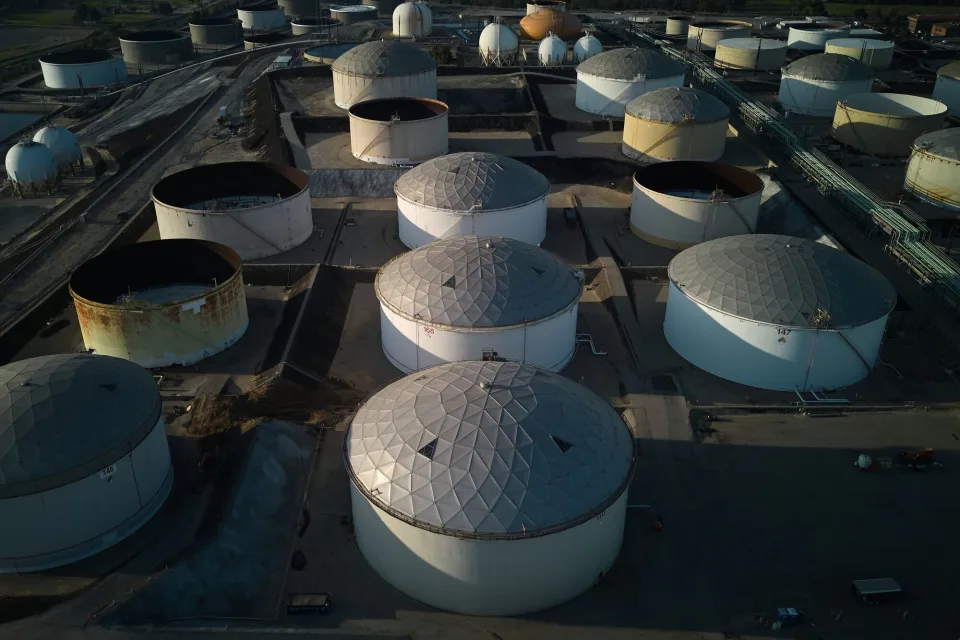Oil prices extended their decline for a third consecutive day amidst concerns of oversupply, as indicated by a key market gauge. The upcoming OPEC+ supply meeting on Sunday added to the uncertainty. Brent crude for August remained near $82 per barrel after experiencing a 1.9% drop on Thursday, while West Texas Intermediate traded below $78 per barrel. Both benchmarks are on track for a monthly decrease. The prompt timespread for Brent also turned bearish for the first time since January, signaling an oversupply situation. The oil market has been influenced by various factors, including recent attacks on a ship in the Red Sea, mixed sentiments from financial markets, and indications of a slowdown in Chinese demand. Despite these factors, oil prices are expected to end the week relatively unchanged. Brent’s gain for the year has now been reduced to less than 10%. In response, OPEC+ is anticipated to extend output cuts, with the possibility of certain restrictions remaining in place until 2025.
Yeap Jun Rong, a market strategist at IG Asia Pte, stated that the upcoming OPEC+ meeting this weekend will play a significant role in determining oil prices in the future. He added that it is unlikely for any further cuts to be implemented, and if they are, it would be a major surprise.
In addition to discussing production cuts, the cartel is also assessing the production capacity levels of its members. Countries such as the United Arab Emirates, Kazakhstan, Iraq, Kuwait, and Algeria are being scrutinized for their potential to increase production next year, according to sources familiar with the discussions.
Traders will also be closely monitoring signs of increased consumption in the US as the summer driving season begins. Data from the Energy Information Administration revealed a recovery in implied gasoline demand, and crude inventories experienced the largest drop since January, indicating a positive trend.
There are indications of a more bearish sentiment in other timespreads as well. The timespread for Brent crude between August and September, which will become the prompt on Monday, has narrowed to 30 cents in a bullish backwardation pattern, compared to 44 cents last week. Similarly, Dubai crude’s timespread for June against July has nearly halved during this period, now standing at 39 cents in backwardation.
Brent crude for August has maintained losses near $82 after experiencing a 1.9% drop on Thursday. Meanwhile, West Texas Intermediate is trading below $78 per barrel, and both are on track for a monthly decline. Additionally, the timespread for Brent has shifted into a bearish contango structure for the first time since January, indicating an oversupply in the market.
Oil prices are expected to remain relatively stable this week despite facing mixed market conditions. Recent events, such as the attack on a ship in the Red Sea, have provided some bullish momentum, while broader financial market trends and signs of weakened Chinese demand have dampened sentiment. The decline in oil prices this month has reduced Brent’s year-to-date gain to less than 10%. In response to these developments, OPEC+ is anticipated to extend output cuts, possibly even into 2025.
The upcoming OPEC+ meeting this weekend will play a crucial role in determining future oil prices. Market strategist at IG Asia Pte, Yeap Jun Rong, highlights the significance of this meeting, noting that any further production cuts would be unexpected and have a significant impact on prices.
In addition to output cuts, the cartel is also examining production capacity levels for its members. Countries such as the United Arab Emirates, Kazakhstan, Iraq, Kuwait, and Algeria are being scrutinized for their potential to increase production next year. Discussions are ongoing regarding the feasibility and implications of such increases.
Traders will also be closely observing any indications that consumer spending in the US is increasing as the summer driving season begins. According to data from the Energy Information Administration, implied gasoline demand is showing signs of recovery, and crude inventories have experienced their largest drop since January.
Additionally, other indicators are pointing towards a more pessimistic outlook. The timespread between Brent crude for August and September, which will soon become the benchmark, has narrowed to 30 cents in a bullish backwardation pattern, down from 44 cents last week. Similarly, Dubai crude for June against July has nearly halved during this period, now standing at 39 cents in backwardation.
